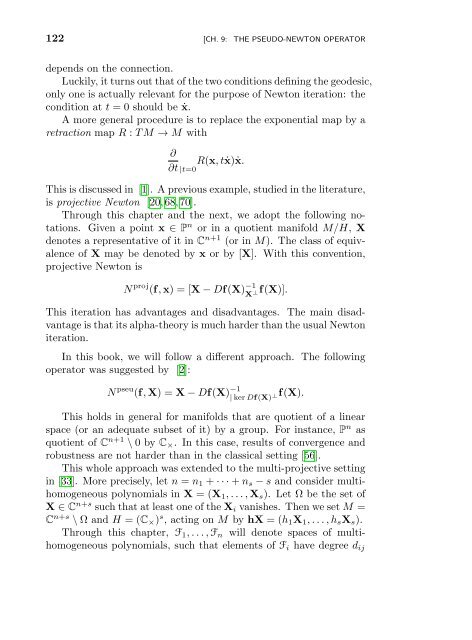Nonlinear Equations - UFRJ
Nonlinear Equations - UFRJ
Nonlinear Equations - UFRJ
You also want an ePaper? Increase the reach of your titles
YUMPU automatically turns print PDFs into web optimized ePapers that Google loves.
122 [CH. 9: THE PSEUDO-NEWTON OPERATOR<br />
depends on the connection.<br />
Luckily, it turns out that of the two conditions defining the geodesic,<br />
only one is actually relevant for the purpose of Newton iteration: the<br />
condition at t = 0 should be ẋ.<br />
A more general procedure is to replace the exponential map by a<br />
retraction map R : T M → M with<br />
∂<br />
R(x, tẋ)ẋ.<br />
∂t |t=0<br />
This is discussed in [1]. A previous example, studied in the literature,<br />
is projective Newton [20, 68, 70].<br />
Through this chapter and the next, we adopt the following notations.<br />
Given a point x ∈ P n or in a quotient manifold M/H, X<br />
denotes a representative of it in C n+1 (or in M). The class of equivalence<br />
of X may be denoted by x or by [X]. With this convention,<br />
projective Newton is<br />
N proj (f, x) = [X − Df(X) −1<br />
X ⊥ f(X)].<br />
This iteration has advantages and disadvantages. The main disadvantage<br />
is that its alpha-theory is much harder than the usual Newton<br />
iteration.<br />
In this book, we will follow a different approach. The following<br />
operator was suggested by [2]:<br />
N pseu (f, X) = X − Df(X) −1<br />
| ker Df(X) ⊥ f(X).<br />
This holds in general for manifolds that are quotient of a linear<br />
space (or an adequate subset of it) by a group. For instance, P n as<br />
quotient of C n+1 \ 0 by C × . In this case, results of convergence and<br />
robustness are not harder than in the classical setting [56].<br />
This whole approach was extended to the multi-projective setting<br />
in [33]. More precisely, let n = n 1 + · · · + n s − s and consider multihomogeneous<br />
polynomials in X = (X 1 , . . . , X s ). Let Ω be the set of<br />
X ∈ C n+s such that at least one of the X i vanishes. Then we set M =<br />
C n+s \ Ω and H = (C × ) s , acting on M by hX = (h 1 X 1 , . . . , h s X s ).<br />
Through this chapter, F 1 , . . . , F n will denote spaces of multihomogeneous<br />
polynomials, such that elements of F i have degree d ij

















